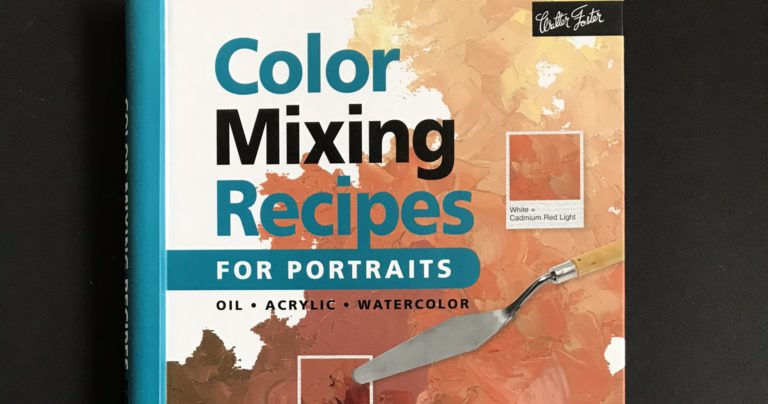Title: Color Mixing Recipes for Portraits – Oil, Acrylic, Watercolor
Author: William F. Powell
Publisher: Walter Foster Publishing
Year: 2006
Pages: 48
Available at: Amazon
About the Author
William F. Powel is an internationally recognized artist and one of America’s foremost colorists. He is the author of many art instructions books, including The Art of Watercolor, Color Mixing Recipes for Watercolor, Color Mixing Recipes for Portraits, and Drawing Made Easy: Dynamic Composition. A native of Huntington, West Virginia, Bill studied at the Art Student’s Career School in New York; Harrow Technical College in Harrow, England; and the Louvre Free School of Art in Paris, France. He has been professionally involved in fine art, commercial art, and technical illustrations for more than 45 years. His experience as an art instructor includes oil, watercolor, acrylic, colored pencil, and pastel—with subjects ranging from landscapes to portraits and wildlife. As a renowned master of color, Bill has conducted numerous “Color Mixing and Theory” workshops in various cities throughout the US. Additionally, he has performed as an art consultant for national space programs and for several artist’s paint manufacturers. Bill’s work has also included the creation of background sets for films, model making, animated cartoons, and animated films for computer mockup programs. He also produces instructional painting, color mixing, and drawing art videos. (Taken from the back of the book)
Book Description
The main part of this book provides you with over 500 combinations of paint mixes for portrait painting, such as the skin tones and facial features. The recipes provided in the book are for oil, acrylic and watercolours. Measuring the right amount of paint is important in following the recipes in this book so a transparent plastic colour-mixing grid is provided at the back of the book for you to measure your paint. Various tips on colour theory to help you create more realistic looking colours.
Contents
Below is a list of contents and a summary of what they include:
Instructions
Talks about how to measure the amount of paint to mix using the Color Mixing Grid that’s provided at the back of the book. Also gives you a list of colors that you will need for all of the combinations in the book.
Skin Tone Palettes
Recipes of mixes of skin tones using yellow ochre and Naples yellow with other colours for a range of basic skin colour mixes.
Color Theory
Talks about tints, tones, shading and greying. Provides some tips on how to modify colours for different skin tones. Example recipes for painting facial planes for ‘Caucasian Warm Tones’ color value and also using tonal values.
Mouth Color Tones
Some tips and recipes for your skin mixes for the mouth.
Ear/nose Color Tones
Some tips and recipes for your skin mixes for the ears and nose.
Oil and Acrylic Skin Tone Recipes
Colour recipes for various skin tones such as Caucasian, Eurasian, Asian, Latino, Black etc.
Color Tones
Recipes for different coloured eyes and hair
Watercolor Skin Tone Recipes
Watercolour Recipes for various skin tones
Creating Colors
Talks about some ways to mix and modify to create your own desired skin tones.
Interested in the book? Get it now by clicking HERE!
My Review
This book does cover a large range of skin tones and some of the colour theory and portraiture tips I found useful for me. However, I’m not a big fan of following exact recipes. I believe that every skin tone will be slightly different depending on the lighting, environment, etc. I prefer mixing my colours depending on my subject and other factors that may affect the skin tone. For example, a person outside in the sun will have warmer skin tones, the same person sitting in a garden full of greeneries will have some greenish tone, when the person is in a room, the type of light(warm or cool) will affect the warmth and colour of the skin, there are many factors to take into considerations depending on the situation which a fixed recipe can’t provide all the time. Still, the book gives me a good starting point for a basic skin mix if I’m not sure where to start and then for me to adjust as I like afterward. In my opinion, this book will be a good start for beginner painters who have limited knowledge and experience in mixing colours for portraits and don’t know where to start. I think that for more experienced painters, this book is probably not a must-have. However, if following recipes is your thing then give this book a try, this book provides you with over 500 colour combinations.
I hope you’ve enjoyed reading this review. If you buy the book using the links I’ve provided I get a small commission which helps me keep making reviews like this.
Here are some of my other book reviews that you may be interested in:
- Figures from Life – Patrick Jones
- Color and light: A Guide for the Realist Painter – James Gurney
- The anatomy of Style – Patrick Jones
- Steal Like an Artist – Austin Kleon










8 Responses
Hi Mary, interesting find on amazon. As I am not an artist, one of my friends is an up and coming artist and this book would be a fantastic gift idea for him.
Thank you very much for sharing your thoughts and best of luck in all your endeavors and your paintings.
Thankyou! Hope your friend will find the book useful!
Wow, tbis is a really good book for those that are starting up with painting. My sister really loves painting and though she’s young, she really has a passion for it. The author of the book is really skilled professional in this field so I can trust his work. I will buy this for my sister seeing its not so expensive and you have recommended it for beginners. Great!
Thankyou! Hope your sister will like the book and find it useful.
I think this book looks like an excellent starting point for the less experienced artist, or maybe someone who is experienced in one medium and is keen to get up to speed as quickly as possible in another. I think you’re right, it’s probably best used as a guide for how to get going quickly with a portrait, and then the colours could be adjusted to suit the particular lighting conditions and environment, and to suit the mood of the piece. Five hundred colour combinations sounds a bit daunting too. Interesting that it deals with ear/nose tones separately. I’ve always struggled with measuring out paint on to one of those mixing grids – is it easy to use?
Thanks! I’ve tried mixing with oil paints but it was difficult to get the exact right amount to perfectly match a colour the first time. I have to go back and add more to get to the colour I want. However, it is a good estimate.
I think this book will be perfect for my daughter, thank you for introducing it. She has just started to get into painting verses drawing and I know she’s very intimidated about attempting portraits.
She is super talented but if a project doesn’t turn out well in the first few tries, she tends to change course and try something else. I am hoping the recipes and tips in this book will inspire her and hopefully hold her attention for a bit longer, even if her first attempts are not to her liking. Thanks again!
Thankyou! Hope your daughter will find the book useful for her.